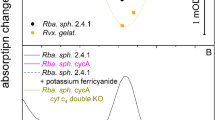Abstract
A SIMPLE method for obtaining non-stationary kinetic data from photo-reactions is to use periodic illumination. The photosynthetic process of Chlorella and other algæ has been extensively studied in this way. The results have been confusing in that different relationships between the photosynthetic yield per flash and the interval between flashes (t d) have been observed. They can be divided into two categories depending upon whether the period of illumination was short (10 µsec. per flash) or long (1 m.sec. per flash or greater). Under conditions of short flashes, the yield per flash reached a maximum value when t d was about 0.03 sec. ; further increase of t d did not change the yield, nor was the maximum yield altered by variation of temperature1–3. With long flashes at high light intensities, greater values of t d were required to secure greater maximum yields per flash than observed with short-period illumination4–6. There has been controversy as to the source of the latter observation ; some authors believing that the carbon dioxide-reducing system of Chlorella is involved, while others single out reactants common to both photosynthesis and the Hill reaction3–7. The latter reaction, named after its discoverer, Dr. Robert Hill8, consists of the photolysis of water by isolated chloroplast preparations or whole Chlorella cells upon illumination in solutions of certain oxidizing agents. There is no participation of carbon dioxide.
This is a preview of subscription content, access via your institution
Access options
Subscribe to this journal
Receive 51 print issues and online access
$199.00 per year
only $3.90 per issue
Buy this article
- Purchase on Springer Link
- Instant access to full article PDF
Prices may be subject to local taxes which are calculated during checkout
Similar content being viewed by others
References
Emerson, R., and Arnold, W., J. Gen. Physiol., 15, 391 (1932); 16, 191 (1932).
Clendenning, K. A., and Ehrmantraut, H. C., Arch. Biochem., 29, 387 (1950).
Ehrmantraut, H., and Rabinowitch, E., Arch. Biochem. Biophys., 38, 67 (1952).
Briggs, G. E., Proc. Roy. Soc., B, 130, 24 (1941).
Weller, S., and Franck, J., J. Phys. Chem., 45, 1359 (1941).
Tamiya, H., and Chiba, Y., Studies Tokugawa Inst., 6, No. 2, Part 1 (1949).
Rabinowitch, E., “Ann. Rev. Phys. Chem.”, 2, 361 (1951).
Hill, R., Nature, 139, 881 (1937).
Author information
Authors and Affiliations
Rights and permissions
About this article
Cite this article
GILMOUR, H., LUMRY, R. & SPIKES, J. Kinetic Evidence for New Participants in the Hill Reaction. Nature 173, 31–32 (1954). https://doi.org/10.1038/173031b0
Issue Date:
DOI: https://doi.org/10.1038/173031b0
Comments
By submitting a comment you agree to abide by our Terms and Community Guidelines. If you find something abusive or that does not comply with our terms or guidelines please flag it as inappropriate.



